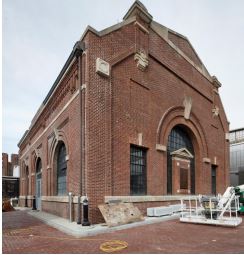
The Gowanus Flushing Tunnel Pumping Station. Image Credit: NYC LPC
The buildings all hold a connection to the Gowanus Canal’s industrial history. On June 25, 2019, the Landmarks Preservation Commission voted to calendar five buildings in Gowanus section of Brooklyn for potential designation as individual landmarks. The five buildings – the Gowanus Flushing Tunnel Pumping Station and Gate House, the Somers Brothers Tinware Factory (later American Can Company), Brooklyn Rapid Transit Company (BRT) Central Power Station Engine House, Montauk Paint Manufacturing Company Building and the American Society for the Prevention of Cruelty to Animals (ASPCA) Rogers Memorial Building. All of the buildings hold a connection to the Gowanus Canal’s industrial history.
The Gowanus Flushing Tunnel Pumping Station and Gate House
The Gowanus Flushing Tunnel Pumping Station and Gate House are located at 196 Butler Street, Brooklyn. The buildings were constructed between 1910 to 1911 by Edwin J. Fort, the Chief Engineer of the Brooklyn Bureau of Sewers. The buildings were constructed as part of an infrastructure project to cleanse the Gowanus Canal.
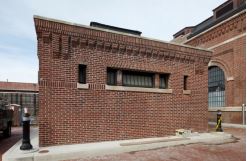
The Gowanus Flushing Tunnel Gate House. Image Credit: NYC LPC
The buildings share similar intricate brickwork facades and robust corbelled cornices. The Gate House has a hipped roof with a square monitor and the Pumping Station has a high gambrel roof.
The Pumping Station contained the tunnel’s pumping and electric motor equipment. The Gate House contained the southern gate valve for the tunnel that connected the Gowanus Canal with Buttermilk Channel in Upper New York Bay. The tunnel opened on June 21, 1911, and operated until 1960 when the tunnel’s propeller mechanism broke. The City did not repair the tunnel until 1999 due to the fiscal crisis. The tunnel went through four years of upgrades and reopened in 2014, where the Pumping Station and Gate House remain in use.
Somers Brothers Tinware Factory
The Somers Brothers Tinware Factory (later known as the American Can Company) is located at 238-246 3rd Street in Brooklyn. The factory was constructed in 1884 in the American Round Arch style with Queen Anne and Neo-Grec details. The Somers Brothers, who moved to Brooklyn after the Civil war to make “brass novelties”, designed the factory. Their tinware business began in 1874 and had grown to 275 employees making 15,000 boxes a day of products by 1884. The Brothers’ work was notable because it was the first in America to decorate tin boxes by printing directly on the tin sheets.
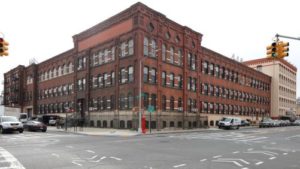
The Somers Brothers Factory. Image Credit: NYC LPC
In May 1884, Daniel Somers filed plans for a new, larger plant that he designed himself. The Landmarks research team highlighted the factory’s red-brick facade with projecting piers, arched openings, and the corner parapet.
Somers Brothers were acquired by the American Can Company in 1901. The factory was converted into artists’ studios in the 1970s. The building is currently occupied by more than 300 artists, publishers, filmmakers, and craftspeople.
Brooklyn Rapid Transit Company (BRT) Central Power Station Engine House
The Brooklyn Rapid Transit Company (BRT) Central Power Station Engine House is located at 153 2nd Street in Brooklyn. The building was constructed from 1901 – 1902 by Thomas E. Murray in the Romanesque-Classical Revival style. It was built for the Brooklyn Rapid Transit Company.
The building features a bold facade with multi-story window openings and subdued ornament that includes brick quoining, shallow corbelled cornices, continuous arch moldings, and bluestone stringcourses. There is a stepped entry portal on the west facade which faces the Gowanus Canal.
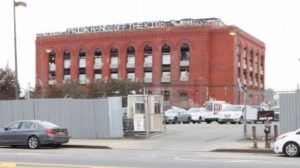
Brooklyn Rapid Transit Company (BRT)
Central Power Station Engine House. Image Credit: NYC LPC
The Power Station had another northern section, which was demolished in 1950 and held the boiler plant. The Engine House provided power to the Fourth Avenue subway (the modern-day D, N and R lines) until it ceased operation in 1972.
The building suffered from neglect for many years, which resulted in the removal of the terra-cotta roof. The building is currently vacant but in 2012 was acquired by the Powerhouse Environmental Arts Foundation, which already plans to rehabilitate the building and construct a new annex.
Montauk Paint Manufacturing Building
The Montauk Paint Manufacturing Building is located at 170 2nd Avenue in Brooklyn. The building was constructed in 1908 by G. George Heghlman for William Kelly, president of the Brooklyn Alcatraz Asphalt Company, who used the site as an investment property. The building was constructed in the American Round Arch style and features ornamented facades with corbelled brick piers.
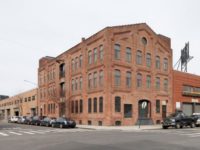
Montauk Paint Manufacturing
Company Building. Image Credit: NYC LPC
The building’s first tenant was the Montauk Paint Manufacturing Company. The company incorporated in 1908 by Frank E. Cornell. The company sold paints and varnishes. The company remained at the building until the 1930s.
American Society for the Prevention of Cruelty to Animals (ASPCA) Rogers Memorial Building
The ASPCA Rogers Memorial Building is located at 233 Butler Street in Brooklyn. The firm of Renwick, Aspinwall & Tucker constructed the building in 1913 and expanded it in 1922. The building is in the Neo-Romanesque style and features two large arches surrounded by molded and patterned brickwork, limestone trim and an arched corbel table featuring colorful tile. The entrance includes a relief of the ASPCA seal, featuring the Angel of Mercy protecting an abused horse. The front of the building also features a granite watering trough hat provided horses and other working animals with fresh water.
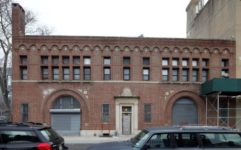
American Society for the
Prevention of Cruelty to
Animals (ASPCA)
Rogers Memorial Building. Image Credit: NYC LPC
The ASPCA has been headquartered in New York City since 1866. The Rogers Memorial building served as a dog and cat shelter and ambulance house for the ASPCA until 1979.
Landmarks will hold a public hearing on the proposed designations at a later date.
By: Veronica Rose (Veronica is the CityLaw fellow and a New York Law School graduate, Class of 2018.)

